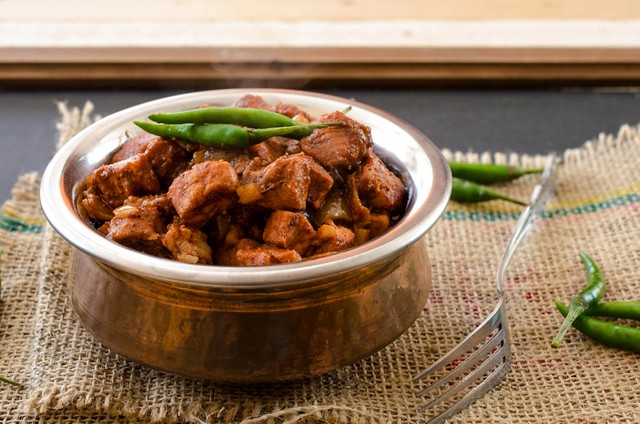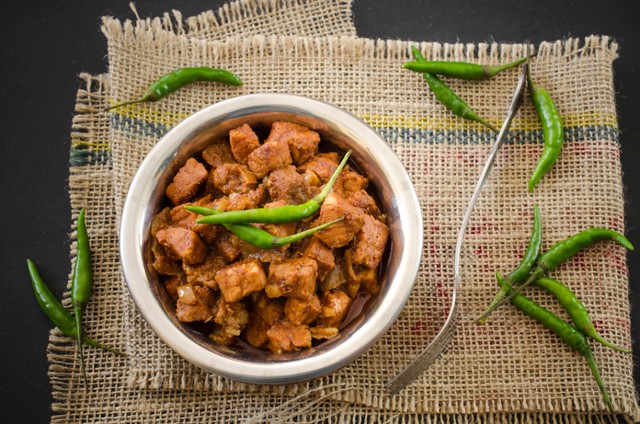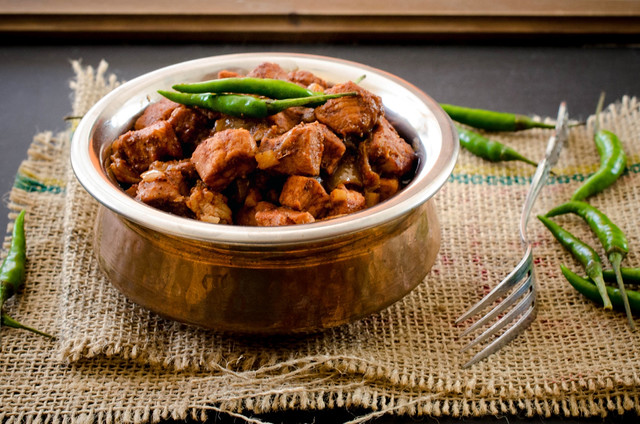
Its a ritual that takes place in almost every Mangalorean Catholic home every Sunday. First, the women of the family are up at an ungodly hour to start the sannas, the batter of which would have been ground the night before. Then the kids are unceremoniously kicked out of bed, and yelled at to get ready, otherwise they're going to be late to Sunday school. After the due religious routines have been followed, said kids may be lucky enough to be taken to a nearby restaurant, duly salivating at the thought of a masala dosa or a idli sambar (a thin rice crepe filled with spicy potato curry, and a steamed, fluffy rice cake, not unlike a sanna, with a hot steaming vegetable stew) Then the men of the family are dispatched to various grocery errands, while the women (and very often, the reluctant, whining, complaining kids who would rather be watching Sunday morning kid's television) would start the (seemingly endless) chopping of onions, ginger, garlic and hot green chillies that could take out an elephant, that was the base of this dukra maas.
The bafat would usually have been made a few weeks earlier, with fresh batches smuggled legally sent to various relatives who live in 'abroad'... and a small batch is left behind for the weekly Sunday ritual of the dukra maas, of course. Once the chopping is all done, the pork is then cubed into small pieces, and the cooking process begins. During the cooking process there will probably be a steady stream of 'I am hungry....' whines coming from all directions. The dog would add a couple of squeaks too... and he may be lucky enough to get a bone for his troubles. The house starts to smell more and more fragrant as the curry simmers away, and the smell is strong enough to lure a few interested neighbours into the fray. They peek at the curry, shoot some breeze, ask a few questions about the provenance of said cooking pig, and then meander away to their own homes, where, perhaps there is another kind of curry cooking.

As the clock creeps to about half past one in the afternoon, the sun is high and the heat is unbearable. The men of the house are getting the cold beers out, and the women are still sweating it out in the kitchen. The pork is still slow cooking, and to this general mayhem, a couple of vegetable dishes have been added, the chopping of which has probably been done by said whining kids, mostly as punishment for the whining. A rice has been cooked, and some chutneys and pickles are pulled out of the fridge. Drinks are being arranged on trays, and little snacks are being greedily consumed... a couple pieces of Mangalorean fried chicken, perhaps? A handful of banana chips? Some potato chips that have been spiced until the eyes water?
Meanwhile, the pork is being seasoned. If one of said kids strategically wanders past as the seasoning is happening, they may get roped into tasting for salt. Is it salted enough? Yep. Does it need any more salt. Nope. How about shirko (vinegar)... maybe a little bit more... and so on, until the curry is salted and simmered to perfection.
And then finally, the shout that everyone has been waiting for comes is yelled out. 'Jhovaan ready... yeawn khaya, weggin' (the meal is ready, come and eat quickly)...
At which point all other activities are abandoned and the great horde of not-so-starving masses descend on the kitchen, load their plates with the steaming curry, the warm sannas, a few mutters of 'now take some vegetables or I'll take that pork away from you right now....' and a spoonful or two of dal. The eating commences, and stomachs of the general population of the house fill up. Some confrontations might occur, a general grumbling of, why did she get more... I want more sannas, why do I have to eat these vegetables... gimme water... I am not doing any dishes, its her turn not mine... blah de blah...
But the pork and the lunch gets eaten, every bite savoured. And peace reigns in the house, as, hungers and thirsts satiated, the populace disappears into darkened, fan cooled rooms for a well deserved siesta.
Now, of course, I may be generalising a wee bit here, but I can guarantee that this is a familiar scene for pretty much ninety percent of Mangalorean Catholics. But, that said, you don't have to be Catholic to enjoy this dish. Simple and savoury, it will grace your table without the associated drama. But as far as I am concerned, a little extra melodrama is always the best way to serve up this dish :)
Recipe:
(Printable Recipe)
1 kg pork, cubed (I like to use pork shoulder, marbled with a little fat)
3 large onions, chopped into large dice
1 or 2 hot green chillies, chopped
3 inches ginger, chopped into small dice
10 - 15 cloves of garlic, chopped into small dice
4 or 5 tbsp bafat powder
1 tsp garam masala
½ tsp ground nutmeg
2 bay leaves
2 - 3 tablespoons tamarind water squeezed from a small ball of tamarind or 2 teaspoons tamarind paste
4 - 5 tablespoons red wine vinegar (or plain white vinegar)
Salt to taste
Method:
Marinate the pork in the bafat, garam masala, nutmeg, salt, ginger, garlic, bay leaves and chillies with vinegar and tamarind water for about 1 hour at room temperature.
Turn up the heat, and start cooking the pork in the same mixture, without adding any more water.
Add the onions 1 hour into the cooking process.
Keep simmering on a low heat until the pork is cooked through, adding a little water as you go. If you like your pork with sauce, add more water as the cooking process continues. As this is a slow cooked dish, it usually takes around 2 - 3 hours for the pork to be cooked. The meat should be tender, but with a little bit of chew... which means it shouldn't be falling apart and the fat should be floating on top when the dish is done.
Adjust the seasoning, adding a touch more salt and vinegar to taste.
Ideally, you want to cook this dish the day before and reheat it, as the taste is much much better the next day. The spices will have had time to get absorbed into the meat.
Serve with sannas, bread or rice.











Hi Michelle,
ReplyDeleteThank you for this wonderful recipe! We tried it for our House Warming party at our new house. Everyone enjoyed it very much... :) As suggested, we had also made the curry one day in advance.. It tasted great the following day..
Thanks,
Leo.
Michelle,
ReplyDeletewhen to add tomato ketchup?
Jessie, only if you need to tone down the heat at the end, and add a little stickiness to the curry. I use/ don't use it depending on the end taste. If you are using it, add it just before the end of the cooking, stir, taste and add a little more if you like.
DeleteHi Michelle,
ReplyDeleteThanks a lot for the recipe. We cooked pork for the first time and it tasted really well:)
Hey Michelle ... That was an amazing and totally apt description of growing up in mlore .. !!! Gosh I'd forgotten all about Sunday catechism and how we'd long to watch cartoons once we were back home from church . Now , living in a far away land, with a little one of my own , I so often wish she could have a glimpse of what her mummy's life was like., growing up. .. Thank you !!
ReplyDeleteThe description took me right back home (bangalore) where bafat pork is a ritual my dad demands and sulks if there isn't any on a sunday :) My mom added raw bananas to it once and it was brilliant- it soaks up all the yummy flavours and is absolutely delicious. Although I live in Austria now I can't do without my trusty bafat.
ReplyDelete"dukra mass" I often hear this word from one of my friends house on the occasion of Christmas eve they always to make this dish
ReplyDeleteI am a tulu and not a catholic but we do eat pork and what you described here brought back so many memories. Specially the tasting bit. We kids used to wait to be called for the tasting and then polish off a quite a bit of pork pretending to taste :) I am in Switzerland now and I have made pork bafat from scratch a couple of times but could not replicate mom's recipe exactly. Will try this out sometime soon. The classic combination at my place was pork and neer dosa.
ReplyDeletenice recipe loved it..
ReplyDeletenice recipe.I loved it.u r blog is wonderful.
ReplyDeleteloved the recipe. One question - you dont use any oil/ghee for this recipe?
ReplyDeleteNope. The fat from the pork adds the richness :)
DeleteHi Michelle: What are the ingredients for Bafat masala?
ReplyDeleteHi Purna, recipe is here: http://www.thetiffinbox.ca/2009/03/bafat-powder.html :) Enjoy.
DeleteThanks, Michelle!
ReplyDeleteHi Michelle. Loved reading the story. I am from Eastern India and have similar stories about family feasting and felt nostalgic. I have cooked this recipe and enjoyed it. Thanks very much!
ReplyDeleteNice ... Turned out to be great.. thank you.. God bless+
ReplyDeleteliked your recipe and more about the descriptions about the getting ready partand the situation before its being servrd,you are rhetoric very prolific.. luv it cudn't help smiling reading it. tnx for sharing this recipe.
ReplyDeletehi michelle, really loved your recipe and all the more enjoyed your descriptions for the process you went through for the preparation, you are rhetoric, i couldn't help smiling reading through, so prolific in description. keep it up! i think you can make a good writer seriously!
ReplyDeleteHi Michelle,
ReplyDeleteI am making this dish today hope it turns out as good it made me feel while reading it.
Manoj